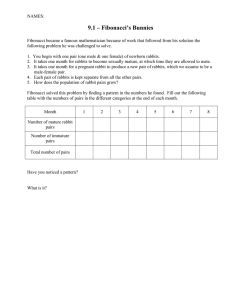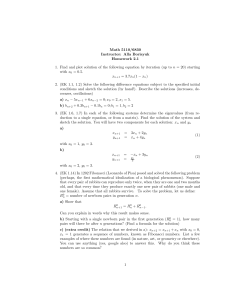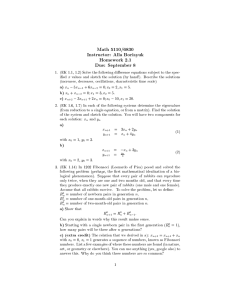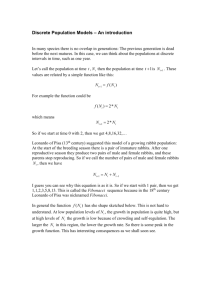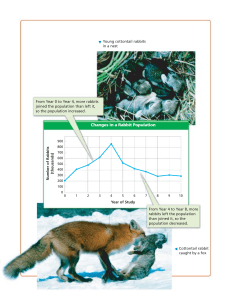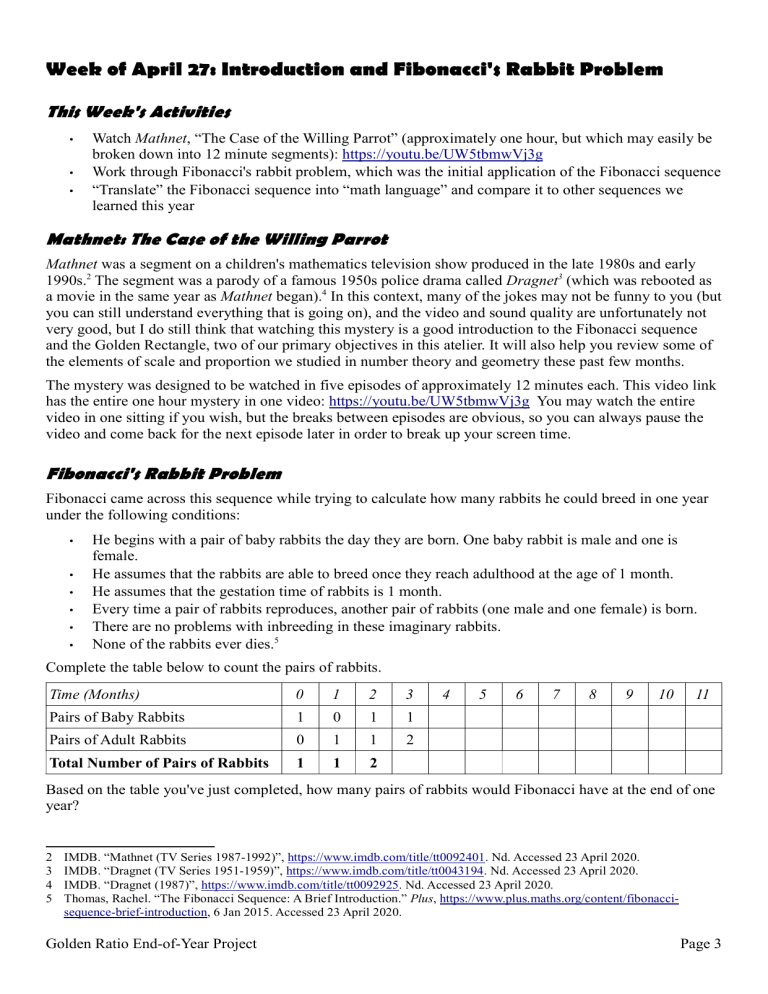
Week of April 27: Introduction and Fibonacci's Rabbit Problem This Week's Activities • • • Watch Mathnet, “The Case of the Willing Parrot” (approximately one hour, but which may easily be broken down into 12 minute segments): https://youtu.be/UW5tbmwVj3g Work through Fibonacci's rabbit problem, which was the initial application of the Fibonacci sequence “Translate” the Fibonacci sequence into “math language” and compare it to other sequences we learned this year Mathnet: The Case of the Willing Parrot Mathnet was a segment on a children's mathematics television show produced in the late 1980s and early 1990s.2 The segment was a parody of a famous 1950s police drama called Dragnet3 (which was rebooted as a movie in the same year as Mathnet began).4 In this context, many of the jokes may not be funny to you (but you can still understand everything that is going on), and the video and sound quality are unfortunately not very good, but I do still think that watching this mystery is a good introduction to the Fibonacci sequence and the Golden Rectangle, two of our primary objectives in this atelier. It will also help you review some of the elements of scale and proportion we studied in number theory and geometry these past few months. The mystery was designed to be watched in five episodes of approximately 12 minutes each. This video link has the entire one hour mystery in one video: https://youtu.be/UW5tbmwVj3g You may watch the entire video in one sitting if you wish, but the breaks between episodes are obvious, so you can always pause the video and come back for the next episode later in order to break up your screen time. Fibonacci's Rabbit Problem Fibonacci came across this sequence while trying to calculate how many rabbits he could breed in one year under the following conditions: • • • • • • He begins with a pair of baby rabbits the day they are born. One baby rabbit is male and one is female. He assumes that the rabbits are able to breed once they reach adulthood at the age of 1 month. He assumes that the gestation time of rabbits is 1 month. Every time a pair of rabbits reproduces, another pair of rabbits (one male and one female) is born. There are no problems with inbreeding in these imaginary rabbits. None of the rabbits ever dies.5 Complete the table below to count the pairs of rabbits. Time (Months) 0 1 2 3 Pairs of Baby Rabbits 1 0 1 1 Pairs of Adult Rabbits 0 1 1 2 Total Number of Pairs of Rabbits 1 1 2 4 5 6 7 8 9 10 11 Based on the table you've just completed, how many pairs of rabbits would Fibonacci have at the end of one year? 2 3 4 5 IMDB. “Mathnet (TV Series 1987-1992)”, https://www.imdb.com/title/tt0092401. Nd. Accessed 23 April 2020. IMDB. “Dragnet (TV Series 1951-1959)”, https://www.imdb.com/title/tt0043194. Nd. Accessed 23 April 2020. IMDB. “Dragnet (1987)”, https://www.imdb.com/title/tt0092925. Nd. Accessed 23 April 2020. Thomas, Rachel. “The Fibonacci Sequence: A Brief Introduction.” Plus, https://www.plus.maths.org/content/fibonaccisequence-brief-introduction, 6 Jan 2015. Accessed 23 April 2020. Golden Ratio End-of-Year Project Page 3 Write it in Math! Now that you've calculated the first twelve numbers of the Fibonacci sequence, let's apply what we already learned about sequences this year, step by step. Vocabulary Review Remember that a sequence is a set whose elements (its numbers) have been listed in a particular order, with some connection between the elements. Each number in the sequence is called a term. The term which is in the nth position in a sequence is called the nth term.6 Finding Relationships in our Sequences In our table on the previous page, we have three sequences: a sequence of the number of pairs of baby rabbits, a sequence of the number of pairs of adult rabbits, and a sequence of the total number of pairs of rabbits. We can use the first row of the table (the number of months that have passed) to identify the position of the term in the sequences. Let's name these sequences B for baby, A for adult, and T for total. Let's check that we understand our vocabulary right. If Bn means “the nth term in the sequence B” and An means “the nth term in the sequence A”, find the following values from the table on the previous page: * A0 * B1 * A7 * B9 * T 11 Now let's look at the relationships between different nth terms in two of our sequences: • How are the terms A0 and B1 related? Using math, we would write this as • How are the terms A1 and B2 related? • Based on the two previous answers, can you make a connection between _____________________ • What is the connection between A1 , B1 , and A2 ? A1 ______ B1 ______ • What is the connection between A2 , B2 , and A3 ? A2 ______ B2 ______ A3 • Based on the two previous answers, can you make a connection between _____________________ A1 ______ A0 ______ B1 B2 An and An , Bn +1 ? A2 Bn and An +1 ? In class, we looked at arithmetic sequences, which had a formula we could use to determine the nth term in a sequence. The Fibonacci sequence is NOT an arithmetic sequence, so we can't use that formula, but there is still a mathematical relationship between consecutive terms in the sequence. See if you can complete the formula below to express that relationship: T n ______ T n+1 ______ T n+2 Another type of sequence you will learn about next year is geometrical sequences, where the ratio between T consecutive numbers in a sequence is important (in math language, we could write this as r = n+1 ). The Tn Fibonacci sequence is not a geometric sequence either, but the farther you go in the sequence, the closer the 6 Morrison, Karen and Nick Hamshaw. “9.1: Sequences” in Cambridge IGCSE Mathematics, Core and Extended Course Book. Rev. ed. Cambridge: Cambridge University Press, 2015, 166-171. Print. Golden Ratio End-of-Year Project Page 4 ratio gets to a stable number. Complete the table below using the values from your table of rabbit pairs to see if you can find an approximation for the ratio in this sequence. r T1 T0 T2 T1 Numerical Value (to 4 significant figures) 1 2 T3 T2 T4 T3 T5 T4 T6 T5 T7 T6 T8 T7 T9 T8 T 10 T9 T 11 T 10 Based on your table, if you continued to do these calculations for 100 terms, or for 1000 terms, what do you think your answer will be (to 4 significant figures)? Golden Ratio End-of-Year Project Page 5
